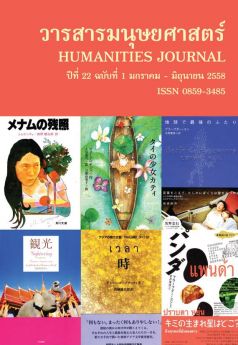ผู้หญิงในนิราศของพลเรือตรี จวบ หงสกุล
Main Article Content
Abstract
นิราศของพลเรือตรี จวบ หงสกุลบันทึกผู้หญิงในฐานะมารดาและภรรยา รวมทั้งผู้หญิงอื่นที่พบระหว่างการเดินทาง ผู้แต่งกล่าวถึงบทบาทของมารดาว่าจะต้องมีหน้าที่ในการอบรมเลี้ยงดูบุตรโดยยกตัวอย่างจากมารดาของตนและผู้หญิงอื่นที่มีสถานภาพเป็นมารดา ส่วนบทบาทของภรรยาปรากฏในฐานะนางอันเป็นที่รักซึ่งผู้แต่งพรรณนาถึงความรู้สึกของตนและรูปลักษณ์ของภรรยาตามขนบและความเป็นจริง นอกจากนี้ยังมีการกล่าวถึงผู้หญิงที่พบระหว่างทางในเชิงสั่งสอน โดยการเปรียบเทียบรูปลักษณ์และความประพฤติของผู้หญิงที่พบกับผู้หญิงที่ดีในอุดมคติของผู้แต่ง นอกจากนี้การกล่าวถึงผู้หญิงในนิราศของผู้แต่งยังเป็นส่วนหนึ่งของพัฒนาการนิราศในช่วง พ.ศ.2496-2509 ซึ่งมิได้เน้นการคร่ำครวญถึงนางอันเป็นที่รักเหมือนอดีตแต่มุ่งบันทึกสภาพสังคมเป็นการกล่าวถึงนางอันเป็นที่รักและผู้หญิงอื่นที่พบระหว่างการเดินทางตามความเป็นจริง และการกล่าวถึงผู้หญิงในลักษณะของวรรณกรรมคำสอนเป็นหลักมีการปรับเปลี่ยนจากการคร่าครวญถึงนางอันเป็นที่รักตามอุดมคติมา
Women in Juab Hongsakul’s Writings in Niras Genre
Phannarai Chanhiran
Rear Admiral Juab Hongsakul’s writings in the niras genre depict women as mothers and wives and other women encountered during a trip. The author discusses the role of the mother, who must be responsible for the rearing of children, by giving as examples his own mother and other women who are mothers. The role of wife appears in the authors’s beloved, his feelings for whom and the characteristics of whom the author describes in both conventional and realistic terms. The other women whom he encountered during the trip serve as object lessons to women by comparing their appearance and behavior with those of his ideal women. In addition, this author’s treatment of women in his writings reflects the development of the niras genre during the A.D. 1953-1966 period. The focus is no longer a lament addressed to a beloved woman as in the conventional niras but rather a depiction of the actual conditions of society. Instead of a lament addressed to an ideal beloved woman, the author describes his beloved and the other women he meets in the course of his journey in realistic terms and his description constitutes a work of didactic literature.


